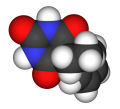Wikisage, the free encyclopedia of the second generation, is digital heritage
Phenobarbitone: Difference between revisions
Jump to navigation
Jump to search
(→ATC) |
|||
| Line 28: | Line 28: | ||
===Veterinary=== | ===Veterinary=== | ||
==ATC== | ==[[ATC code N03|ATC]]== | ||
<ref>https://www.whocc.no/atc_ddd_index/?code=N03AA02</ref> | <ref>https://www.whocc.no/atc_ddd_index/?code=N03AA02</ref> | ||
| Line 36: | Line 36: | ||
{{Wikidata|Q407241}} | {{Wikidata|Q407241}} | ||
{{refs}} | |||
[[Category:GABAA_receptor_positive_allosteric_modulators]] | [[Category:GABAA_receptor_positive_allosteric_modulators]] | ||
Latest revision as of 15:14, 25 October 2024
(BAN) or phenobarbital is a WHO recommended AED
phenobarbital induces enzymes of the cytochrome P450 system; like phenytoin, carbamazepine, and primidone.[1]
Osteomalacia
The Impact of Anti-Epileptic Drugs on Growth and Bone Metabolism
antiepileptic drug-induced bone loss in young male patients who have seizures
Status epilepticus
Treatment of Established Status Epilepticus
Post encephalitic epilepsy
Effect of Antiepileptic Drugs for Acute and Chronic Seizures in Children with Encephalitis
- Lin K-L, Lin J-J, Hsia S-H, Chou M-L, Hung P-C, Wang H-S, et al. (2015) Effect of Antiepileptic Drugs for Acute and Chronic Seizures in Children with Encephalitis. PLoS ONE 10(10): e0139974. doi:10.1371/journal.pone.0139974
Cysteinyl leukotrienes
Montelukast reduces seizures in pentylenetetrazol-kindled mice
Otros
Uses
Human
Veterinary
ATC
| References: |
